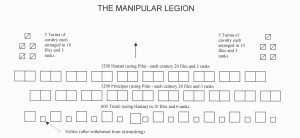MANIPULAR LEGION
Organization of Legion
The early Roman Manipular Legion, used from the fourth century B.C. until the Marian Reforms of 107 B.C., was the largest and most basic unit of the army’s composition. The Roman Army consisted of four Legions, each with the strength of roughly 4200 infantrymen.
The Legion, when formed up for battle, had three lines of infantry: first were the hastati, then the principes, and finally the veteran triarii. Each of these three lines contained five manipuli of 120 hastati, 120 principes, and sixty triarii. A maniple was further subdivided into two centuriae of sixty each hastati and principes, and thirty triarii. Each century had six squads; a squad, aptly named contubernium (“tenting-together”) in Latin, shared a tent when the Legion went on campaigns.
Manipular Legions were supported by ten thirty-man squadrons (turmae) of equites, light cavalry, and the more loosely organized velites, skirmishing troops.
The manipular formation would be initially deployed in four lines. The first was a solid line made up of the skirmishing velites, who would hurl missiles at the approaching enemy to inflict casualties and disrupt their formations. The final three lines known as the triplex acies were made up of the infantry, a line each for the hastati, principes and triarii. These three lines would be segmented and deployed in a checkerboard pattern known as a quincunx. When the marching enemy would get close the velites would retreat through the gaps in the maniples to the rear of the formation. The front line of hastati then would most likely have formed a solid line to engage the enemy in close-quarters combat. If the front line could not hold, they would fall back on the principes. If that line could not hold they would then fall back on the triarii.
Organization of Leadership
Typically, each of Rome’s two consuls would have two Legions at his disposal. A Legion was commanded by six tribunals; a pair of tribunals would command the Legion for two months at a time, switching off command with each other every day and rotating to the next pair at the end of two months.
Centurions commanded each century of infantry; a maniple would have two centurions, giving the Legion ten centurions per line of infantry, or thirty centurions in total. Decurions commanded each cavalry turma.
COHORTAL LEGION
Organization of Legion
Following the Marian Reforms in 107 B.C., Roman Legions were heavily restructured. The three lines of distinct infantry present in the Manipular Legion were abandoned in favor of the new legionnaires.
Legions contained ten cohorts. Each cohort, roughly 480 legionnaires, was subdivided into six centuries of eighty men each. Centuries were then divided into ten eight-man contubernia.
The first cohort of each Legion held that Legion’s silver eagle standard and accordingly became a position of great honor. First cohorts contained five centuries, rather than the typical six, but each century was double strength; this led to a cohort of 800 legionnaires, rather than the standard 480.
All non-legionary troops in the period following the Marian Reforms were referred to as auxilia. The auxilia equivalents of the cohorts were alae. Cavalry, now organized as auxilia units, grew to sixteen turmae.
Organization of Leadership
Command of the Cohortal Legion is less certain than that of the Manipular Legion. No commander with power equivalent to that of the tribune is known to exist in the Cohortal Legion.
The centurion who commanded the first century of each cohort also commanded that cohort; this senior centurion was given the title pilus prior. Of the ten cohorts in each Legion, the tenth cohort was most junior. Legionnaires advanced in experience and centurions advanced in seniority in each cohort, with the first cohort consisting of the Legion’s most experienced and prestigious soldiers. The five centurions of the first cohort were senior to all other centurions; these officers where the primi ordines. The most senior among the primi ordines, the commander of the first cohort and thus all other centurions, cohorts, and centuries, was the primus pilus, most prestigious position held by a Legionary soldier.
Each centurion had under his command three principales (the signifier, optio, and tesserarius), and many immunes, a separate class of soldier that was exempt from certain soldierly duties due to the possession of a special skill, such as blacksmithing or carpentry. The signifier was the century’s standard-bearer, an optio was a centurion-in-training and second-in-command of the century, and the tesserarius maintained the daily obligations of the century, especially the daily password and operation of the night watch when the Legion campaigned.




